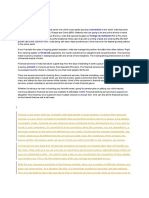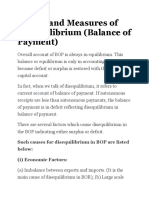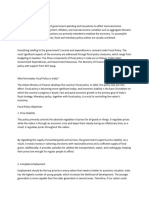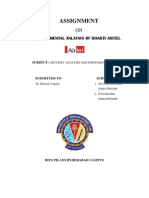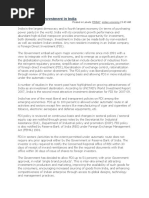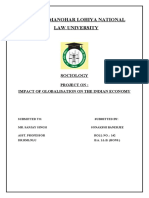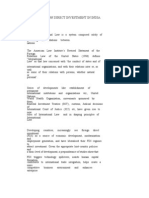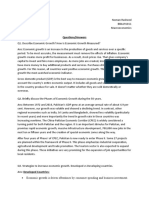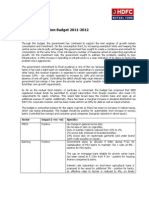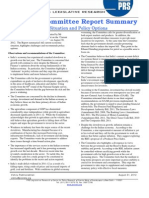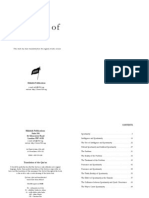Economic Reforms: Kirit Jain Roll No:14
Uploaded by
kirit1990Economic Reforms: Kirit Jain Roll No:14
Uploaded by
kirit1990KIRIT JAIN ROLL NO:14
ECONOMIC REFORMS
DEFINATION
Reform means the improvement or amendment of what is wrong, corrupt, unsatisfactory, etc. The use of the word in this way emerges in the late 1700s and is believed to originate from Christopher Wyvills Association movement which identified Parliamentary Reform as its primary aim. In India, at least for the past three years, and arguably for much longer, such an approach has proved impossible. While the economy grew fast, politicians both national and regionalpreferred to argue about spending revenues rather than promoting growth. Each time Manmohan Singh, the prime minister, or his supporters, tried to raise an economic reform, such as allowing foreign supermarkets on to Indian soil, the political rage grew intolerable from opposition parties and the governments own allies. Mr Singh, timid, elderly and without robust backing from his party chief, Sonia Gandhi, would then back down. Thus Indias way of promoting reforms has had to be different. Getting any political backing for them has instead required a sharply slowing economygrowth is now down to nearer 5% a year, from a peak of 10%investors who refuse to spend, a grim fiscal position and a host of other alarming economic signs. And rather than announce changes piecemeal, the government of Mr Singh has gone for a big bang, a rush of reforms. The political reaction could be severe: but his boldness is both welcome and overdue. On September 13th came an announcement of a small, but politically important, reduction in diesel subsidies. Through state-owned firms the government has long kept the price of diesel artificially low. But as market prices have soared, the subsidy bill has exploded, helping to turn a bad fiscal situation into a dreadful one. India has been set to miss, by a mile, its deficit targets. The 12% increase in the price of diesel that Indian drivers (and those with generators) are now enduring will be politically difficult, but it is
essential. It was the better-off who gained most from costly fuel subsidies, while the fiscal problems hurt the economy as a whole.
RECENT REFORMS
MUTUAL FUND REFORM
Investments in mutual funds will get simpler and safer-- but a bit costlier in some cases-starting on Monday as the industry is set to implement some wide-ranging reforms by market regulator Sebi. Among various reform measures taken by Sebi (Securities and Exchange Board of India), the fund houses will have to make more disclosures in the interest of investors. They also have to shift to the one plan per scheme model, moving away from the present practice of cluttering one scheme with numerous plans. At the same time, fund houses will be able to charge their investors a little bit more as incentive for expanding to small cities, but would also have to set aside a small portion of their assets for investor education and awareness. The changes in mutual fund regulations were approved by Sebi's board in its last meeting on August 16 and have been notified over the past few days. Now, these would come into effect from tomorrow, October 1. As per the notifications, the fund houses might charge investment and advisory fee on their schemes, which would have to be fully disclosed in the offer document. In case of a fund of funds scheme, the total expenses of levied on the scheme would be capped at 2.50 per cent of the daily net assets of the scheme. In addition to the total expenses already levied on schemes, Sebi would allow the fund houses to levy brokerage and transaction costs, which is incurred for the purpose of execution of trade and is included in the cost of investment, with a ceiling of 0.12 per cent in case of cash market and 0.05 per cent in case of derivatives transactions. Besides, mutual funds can charge additional expenses of up to 0.30 per cent of daily net assets, if the new inflows from places other than top-15 cities are 30 per cent of the gross new inflows in the scheme, or are 15 per cent of the average assets under management (year to date) of the scheme, whichever is higher. The expenses charged under these clauses would have to be utilized for distribution expenses incurred for bringing inflows from such cities, and the amount incurred as expense on account of inflows from such cities would have to be credited back to the scheme in case the said inflows are redeemed within a period of one year. Among other measures, the fund houses would have to calculate the Net Asset Value
(NAV) of the scheme on daily basis and publish the same in at least two daily newspapers with nation-wide circulation. Also, any exit load charged by the fund houses would have to be credited to back to the scheme.
Coalition Politics Behind Slow Reform
Admitting that corruption scandals and coalition compulsions have slowed down reforms, a day ahead of the Budget, the government today said it is facing fiscal slippages and made a strong pitch for raising tax resources. The Reserve Bank too expressed concern over the deteriorating state of government finances and called for fiscal consolidation to control inflation. The government, in the Economic Survey shared RBI's concerns that inflation and fiscal slippages were among the main challenges before the economy. It said there was a slackening in the pace of reforms and high-profile corruption scandals along with "welcome civil society activism" have led to delay in decision making by bureaucrats. The Survey presented before Parliament by Finance Minister Pranab Mukherjee said, "the coalition politics and federal considerations played their roles in holding up economic reforms on several fronts, ranging from diesel and LPG pricing...to...FDI in retail." It also attributed economic slowdown partly to domestic issues "like pressures of democratic politics". RBI, while keeping interest rates unchanged to keep prices under control in its monetary policy review, pointed to the deterioration in central government finances. "Credible fiscal consolidation will be an important factor in shaping the inflation outlook," RBI Governor D Subbarao said. Agreeing with the RBI on the need for fiscal consolidation, the Survey said: "The principal way in which this has to be achieved is by raising tax-GDP ratio and cutting down wasteful expenditures." At present the ratio is 10.5 percent, "and all effort has to be made to raise this". The Survey was also endorsed RBI's views with respect to inflationary challenges facing the economy. "...vigilance will be required and steps need to be taken to quickly deal with any unexpected developments and global shocks such as increases in the price of crude oil," it said. While both RBI and the government projected better outlook in the coming financial years -- 2012-13 and 2013-14, they attributed the slowdown in the economy in the current fiscal to global and domestic factors. After close to 7 percent growth in 2011-12, the government expects economic expansion to be around 7.6 percent in the next fiscal. Economy was growing at over nine percent before the global financial crisis
pulled down the growth rate to 6.7 percent in 2008-09. It was 8.4 percent in the last two financial years.
FDI Foreign Direct Investment
When a firm controls (or have a strong say in) another firm located abroad, e.g. by owing more than 10% of its equity, the former is said "parent enterprise" (or "investor") and the latter "foreign affiliate". Foreign Direct Investment (FDI) is the financial investment giving rise and sustaining over time the investor's significant degree of influence on the management of the affiliate. The initial investment can be the purchase of an existing firm (by acquisition or by merger, the so-called "M&A") as well as the foundation of a new legal entity who usually - but not necessarily - makes a green-field real investment (e.g. building a factory) in the foreign country. In a broader definition, FDI consists of the acquisition or creation of assets (e.g. firm equity, land, houses, oildrilling rigs,...) undertaken by foreigners. If in these enterprises they are not alone but act together with local firms and/or governments, one talk of "joint ventures". A country outflows of FDI means that it is "exporting money" to "buy" or "build" foreign productive capacity, whose ownership will remain in the first country's hands.
FDI in Multi Brand Retail Sector India
The recently declared policy of the Government of India regarding foreign direct investment in the Multi- brand Retail sector of India is like a welcome and great boon to all foreign retailers and investors. The Government of India has now finally decided to allow FDI up to 51% in the Multi-brand Retail sector of India. For a long time, the vast $450 billion retail market of India has been striking and alluring to foreign investors and retailers of the world over, for making highly profitable and secure foreign direct investment. Now, they are fully enabled and well-facilitated to perform such lucrative investments in huge and constantly growing retail sector of India. Some of the most outstanding features of the retail sector of India are described, as service to all foreign retailers, companies, and investors of diverse sectors of commerce and industry. Ours prestigious and globally reputed legal organization is well-equipped to provide prompt and impeccable services for most secure and productive foreign direct investment in Indian retail sector. Ours well-experience law firm has been offering refined and swift legal services to people and entities in almost all economic sectors in India and countries worldwide. Today, the retail industry of India is estimated to be worth US $ 450 billion, and by dint of this economic value, it is regarded as one of the top five largest retail markets in the whole world. The constantly growing economy of India with an average rate of 8% and India's 1.2 billion people, together make the retail industry of India highly growth-oriented and immensely profitable in present and future times. As per an estimate by mellow and expert economists, the retail market of India can reach the level
of around $ 650 billion by the year 2015. The latest decision of Indian Government is to boost the growth in retail, further more. According to percipient and discerning economists, the organized retail sector of India has potential to grow at the rate of over 15% every year, especially after this visionary decision of Indian Government. Currently contributing to about 15% of the national GDP of India, the Indian retail sector is expected to entice huge FDI ranging from $2.5 - 3 billion in the next five year, after this liberalizing and visionary decision of Indian Government. Foreign investors, retailers, and companies of the world over, including the Wal-Mart of USA, Metro of Germany, Carrefour of France, Tesco of UK, etc., are now fully free and well-facilitated to make their majority stake investments in the multi-brand retail sector of India, for bright and promising future. The significant recommendations of the latest FDI liberalization policies of India, in multi-brand retail sector, are the following: The minimum level of FDI in multi-brand retail sector will be worth $ 100 million Supermarkets are allowed in only those cities of India whose population is at least 1 million At least 50% of the total investment will be made on the Back-end Infrastructure And, at least 30% of their goods and products will be procured from the local companies and industries.
FDI in Single Brand Retail Sector India
Till 2011, foreign direct investment in the single-brand retail sector of India was limited to 51%. Now, as per the recent development and declaration of the Government of India (made in September 2012), this limit is finally extended up to 100% ownership by foreign retailers and investors. Thus, great and elusive opportunity for entering into vast and abundant retail sector of India is now generously offered to all foreign companies, retailers, and investors of the world over. To globally prominent and popular singlebrand retailers like IKEA, Apple, Nike, and several others, this declaration of Indian Government is certainly a magnificent boon. Exclusive and refined information about the retail sector of India is being provided below, as service to our Indian and global visitors. The retail market of India is one of the largest and most progressive retail markets in the whole world, with a high growth rate equaling to 15% every year. Currently, the retail industry of India (including both single-brand and multi-brand) is worth US $450 billion, and contribute about 15% to the national GDP of India every year. Almost all sectors of Indian economy have been developing and progressing fast constantly since a decade, to expand and enrich the retail industry also, besides all other sectors. The national GDP growth rate of 8% has been boosting the financial status of the majority of Indian population, to enhance their purchasing power. Moreover, the organized retail sector of India is inadequately developed, and thus, has ample potential for tremendous growth, as in many well-developed nations of the world. After the recent FDI liberalization policies in the retail sector of India, the organized retail sector
of India is expected to grow with a rate of over 10% every year. The foreign direct investment in the single-brand and multi-brand retail sectors is hoped to reach the level of US $ 2.5-3 billion, in the next five years. However, the foreign single-brand retailers will have to procure at least 30% of their products and goods from the local or domestic industries and companies, to do business in India. Providing well-rounded, perfect, and swift legal help and services for foreign direct investment in India in its diverse sectors, we are well-equipped to offer legal services for FDI in the retail sector of India, under both the categories of single-brand retail and multi-brand retail. Here, it may be noted that in the multi-brand retail sector, the permitted level of FDI is up to 51% only, according to the latest governmental declaration.
FDI in Airlines India
The latest visionary decision of the Government of India to allow FDI up to 49% in India's domestic aviation, is expected to heal the cash-strapped aviation industry of India, and attract massive foreign direct investment in the aviation sector of India, in short and long future. Consequently, the huge aviation sector of India will flourish luxuriantly in near future, to become one of the largest and most glamorous aviation industries in the whole world. Rich, refined, and exclusive information regarding the Indian aviation sector, is being offered in the section below, as service to our Indian and foreign visitors. Ours globally famous and reputed law firm has been extending perfect and punctilious legal services to all sectors of economy in India and countries worldwide, essentially including the galloping aviation sector. For ours swift and economical legal services to the aviation sector please refer to other articles with similar titles, in ours this website. We offer all-round and expert legal services for foreign direct investment in the aviation sector of India and abroad. According to a recent RNCOS Report, India is one among the top ten largest markets of the world, in respect of aviation, and is growing tremendously with a high growth rate of 15% every year, to become one of the top five aviation markets in the whole world by 2020. The aviation sector of India has been serving about 100 million aviation travelers every year, both international and domestic, in the recent years. India's domestic aviation market has also been growing rapidly with growth rates of over 15% every year since past few years. According to a report published by International Air Transport Association (IATA) in June 2011, the domestic aviation market of India will emerge out as the third biggest domestic aviation market in the entire world by 2020 with over 450 million domestic passengers, after the domestic markets of USA and China. The latest FDI policies of the Government of India in the aviation sector are therefore, to entice remarkable and huge foreign direct investment in the Indian aviation industry, by foreign aviation companies, carriers, and investors, in near and far future. It is evident from the above elucidation that, the aviation sector of India, is considered as one of the most secure and profitable destinations in the entire world, for FDI in aviation. India's vast and ever-growing economy is to enhance the
number of air travelers at domestic and international levels, which in turn, will promote further growth and prosperity in the aviation sector of India.
INSURANCE The Cabinet on 4TH October 2012 approved a Bill seeking to increase in the FDI cap in insurance from 26 per cent to 49 percent. The insurance regulator has backed the move. The announcement has been welcomed by the industry, which has been struggling to raise capital for a while. "The FDI increase to 49 per cent is essential for this capitalintensive industry that requires long-term investments. It will encourage more participation of foreign partners in insurance firms and lead to product development and innovation," says T R Ramachandran, CEO and MD, Aviva India. The four public sector general insurance companies - National Insurance, New India Assurance, Oriental Insurance and United India Insurance - along with General Insurance Corporation, the reinsurer, will also be permitted to raise capital from the market. However, the government's holding will not fall below 51 per cent.
PENSION FUND:
The government has allowed overseas companies to own upto 26% in pension funds. While talking about the proposed FDI cap for pension funds, Dhirendra Swarup, Former Chairman, Pension Fund Regulatory and Devlopment Authority (PFRDA), said that the move will bring in greater fund management expertise and will bring in competition. The consumer is going to gain to a large extent. However, investment norms will have to be reinvested, he pointed out.
Tripartite model of infrastructure debt fund
Setting up of Infrastructure Debt Funds (IDFs) was announced in the Union Budget for 2011-12. These are aimed at accelerating and enhancing flow of long term debt for funding infrastructure projects in the country. They will also act as a catalyst to channelize domestic savings. IDFs would provide a vehicle for refinancing the existing debt of infrastructure projects which are funded mostly by commercial banks. This would create fresh headroom for commercial banks and enable them to take up a larger number of new infrastructure projects. An IDF can be structured either as a company or as a trust. If set up as a trust, it would be regulated by SEBI under the Mutual Fund
Regulations. If set up as a company, the IDF would be structured as a Non-Banking Finance Company (NBFC) and will be under the regulatory oversight of RBI. Guidelines with enabling provisions have already been issued by the Reserve Bank of India and SEBI. An IDF-NBFC would issue either rupee or dollar denominated bonds and invest only in debt securities of Public Private Partnership projects which have a buy-out guarantee and have completed at least one year of commercial operations. Such projects are expected to be viewed as low-risk investments and would, therefore, be attractive for risk-averse insurance and pension funds.
Competition Commission of India
The Cabinet gave the green signal to amendments in the Competition Act, bringing all voluntary mergers and acquisitions in all sectors under the purview of the Competition Commission of India (CCI). Specific cases such as the merger of a failed bank with another in the public interest will, however, be exempted from CCI purview and be in accordance with Reserve Bank of India directions. The Cabinet also gave its nod to the Forward Contracts Regulation (Amendment) Bill to give more teeth to the Forward Markets Commission and introduce more products in commodity futures.
Forward Contract Amendment Bill
The Cabinet approved the Forward Contract Regulation Act (Amendment) Bill, which seeks to give more powers to the Forward Markets Commission (FMC), the commodity markets regulator. It will strengthen the FMC by providing it with financial autonomy, facilitate the entry of institutional investors and introduce new products for trading such as options and indices.
Amendment in Companies bill 2011
The Cabinet also approved certain amendments to the Pension Fund Regulatory and Development Authority Bill. These amendments have been necessitated in view of the recommendations of the Standing Committee on Finance, which has examined the Bill. The government has decided to accept five key recommendations, an official release said. Though the cap on FDI in the pension sector has not been announced, Finance Minister P. Chidambaram said it would be of the same order of 49 per cent as in the insurance sector
You might also like
- c. Macroeconomic Aggregates and PoliciesNo ratings yetc. Macroeconomic Aggregates and Policies5 pages
- Get Black Money Into Circulation: Hinduja Group Chairman S P HindujaNo ratings yetGet Black Money Into Circulation: Hinduja Group Chairman S P Hinduja13 pages
- Fdi: Foreign Direct Investment: EarningNo ratings yetFdi: Foreign Direct Investment: Earning14 pages
- Helping You Spot Opportunities: Investment Update - August, 2013No ratings yetHelping You Spot Opportunities: Investment Update - August, 201355 pages
- Effects of Fiscal Policy On Indian FirmsNo ratings yetEffects of Fiscal Policy On Indian Firms14 pages
- Liberalisation Privatisation and Globalisation in India: 3.globalizationNo ratings yetLiberalisation Privatisation and Globalisation in India: 3.globalization41 pages
- Helping You Spot Opportunities: Investment Update - October, 2012No ratings yetHelping You Spot Opportunities: Investment Update - October, 201256 pages
- Abhyaas Business Bulletin - January 16th, 2012No ratings yetAbhyaas Business Bulletin - January 16th, 20124 pages
- Recent Development in Global Financial MarketNo ratings yetRecent Development in Global Financial Market8 pages
- Related Posts:: Deficit Financing The ImpacNo ratings yetRelated Posts:: Deficit Financing The Impac4 pages
- Foreign Direct Investment in India: Posted in Labels: ESSAY, Indian Economy - 5:43 AMNo ratings yetForeign Direct Investment in India: Posted in Labels: ESSAY, Indian Economy - 5:43 AM3 pages
- A Stimulus To Economy Sentiments and Investments-1No ratings yetA Stimulus To Economy Sentiments and Investments-12 pages
- Economics: Full Convertibility On Capital Account Unlikely For Few YearsNo ratings yetEconomics: Full Convertibility On Capital Account Unlikely For Few Years52 pages
- DR - Ram Manohar Lohiya National Law University: SociologyNo ratings yetDR - Ram Manohar Lohiya National Law University: Sociology7 pages
- An Overview of National Budget in BangladeshNo ratings yetAn Overview of National Budget in Bangladesh4 pages
- Standing Committee Report Summary: Current Economic Situation and Policy OptionsNo ratings yetStanding Committee Report Summary: Current Economic Situation and Policy Options2 pages
- The Cost and Benefit of Higher Government DebtNo ratings yetThe Cost and Benefit of Higher Government Debt6 pages
- KPMG Flash News Economic Survey 2010 11No ratings yetKPMG Flash News Economic Survey 2010 1110 pages
- ADB International Investment Agreement Tool Kit: A Comparative AnalysisFrom EverandADB International Investment Agreement Tool Kit: A Comparative AnalysisNo ratings yet
- Vdocuments - MX Downloads06072015list of Registered Reg No Name in Full Residential AddressNo ratings yetVdocuments - MX Downloads06072015list of Registered Reg No Name in Full Residential Address2,925 pages
- Name-Gayatri M. Kale F1 - 15 Asian Paints Date Announcement Op - Price CL - PriceNo ratings yetName-Gayatri M. Kale F1 - 15 Asian Paints Date Announcement Op - Price CL - Price1 page
- Islam, Democracy, and Constitutional LiberalismNo ratings yetIslam, Democracy, and Constitutional Liberalism21 pages
- Glucose Measurements: Mustafa Adalgadir Khandgawi 2016No ratings yetGlucose Measurements: Mustafa Adalgadir Khandgawi 201622 pages
- LabSheet1 - Familiarization of Lab MaterialsNo ratings yetLabSheet1 - Familiarization of Lab Materials6 pages
- Students' Reasoning in Fluid Dynamics: Bernoulli'S Principle vs. The Continuity EquationNo ratings yetStudents' Reasoning in Fluid Dynamics: Bernoulli'S Principle vs. The Continuity Equation8 pages
- 1 - Bagatelles Et Impromptus: VII. Love - Bedřich SmetanaNo ratings yet1 - Bagatelles Et Impromptus: VII. Love - Bedřich Smetana2 pages
- Multidimensional Measure of Psychological Responses To Appraisals of Anomalous Experiences Interview (AANEX) : ANo ratings yetMultidimensional Measure of Psychological Responses To Appraisals of Anomalous Experiences Interview (AANEX) : A11 pages
- Constitutional Design Question and AnswersNo ratings yetConstitutional Design Question and Answers2 pages
- Valproic Acid and Risperidone: A Drug Interaction?: To The EditorNo ratings yetValproic Acid and Risperidone: A Drug Interaction?: To The Editor2 pages
- FAQ-How NGWDM Amplifier Works and How To Calculate The OSNRNo ratings yetFAQ-How NGWDM Amplifier Works and How To Calculate The OSNR11 pages
- Personnel Administration / Human Resource Management - Concept, Meaning & Importance of Its DevelopmentNo ratings yetPersonnel Administration / Human Resource Management - Concept, Meaning & Importance of Its Development14 pages
- Get Black Money Into Circulation: Hinduja Group Chairman S P HindujaGet Black Money Into Circulation: Hinduja Group Chairman S P Hinduja
- Helping You Spot Opportunities: Investment Update - August, 2013Helping You Spot Opportunities: Investment Update - August, 2013
- Liberalisation Privatisation and Globalisation in India: 3.globalizationLiberalisation Privatisation and Globalisation in India: 3.globalization
- Helping You Spot Opportunities: Investment Update - October, 2012Helping You Spot Opportunities: Investment Update - October, 2012
- Foreign Direct Investment in India: Posted in Labels: ESSAY, Indian Economy - 5:43 AMForeign Direct Investment in India: Posted in Labels: ESSAY, Indian Economy - 5:43 AM
- A Stimulus To Economy Sentiments and Investments-1A Stimulus To Economy Sentiments and Investments-1
- Economics: Full Convertibility On Capital Account Unlikely For Few YearsEconomics: Full Convertibility On Capital Account Unlikely For Few Years
- DR - Ram Manohar Lohiya National Law University: SociologyDR - Ram Manohar Lohiya National Law University: Sociology
- Standing Committee Report Summary: Current Economic Situation and Policy OptionsStanding Committee Report Summary: Current Economic Situation and Policy Options
- ADB International Investment Agreement Tool Kit: A Comparative AnalysisFrom EverandADB International Investment Agreement Tool Kit: A Comparative Analysis
- Vdocuments - MX Downloads06072015list of Registered Reg No Name in Full Residential AddressVdocuments - MX Downloads06072015list of Registered Reg No Name in Full Residential Address
- Name-Gayatri M. Kale F1 - 15 Asian Paints Date Announcement Op - Price CL - PriceName-Gayatri M. Kale F1 - 15 Asian Paints Date Announcement Op - Price CL - Price
- Glucose Measurements: Mustafa Adalgadir Khandgawi 2016Glucose Measurements: Mustafa Adalgadir Khandgawi 2016
- Students' Reasoning in Fluid Dynamics: Bernoulli'S Principle vs. The Continuity EquationStudents' Reasoning in Fluid Dynamics: Bernoulli'S Principle vs. The Continuity Equation
- 1 - Bagatelles Et Impromptus: VII. Love - Bedřich Smetana1 - Bagatelles Et Impromptus: VII. Love - Bedřich Smetana
- Multidimensional Measure of Psychological Responses To Appraisals of Anomalous Experiences Interview (AANEX) : AMultidimensional Measure of Psychological Responses To Appraisals of Anomalous Experiences Interview (AANEX) : A
- Valproic Acid and Risperidone: A Drug Interaction?: To The EditorValproic Acid and Risperidone: A Drug Interaction?: To The Editor
- FAQ-How NGWDM Amplifier Works and How To Calculate The OSNRFAQ-How NGWDM Amplifier Works and How To Calculate The OSNR
- Personnel Administration / Human Resource Management - Concept, Meaning & Importance of Its DevelopmentPersonnel Administration / Human Resource Management - Concept, Meaning & Importance of Its Development








